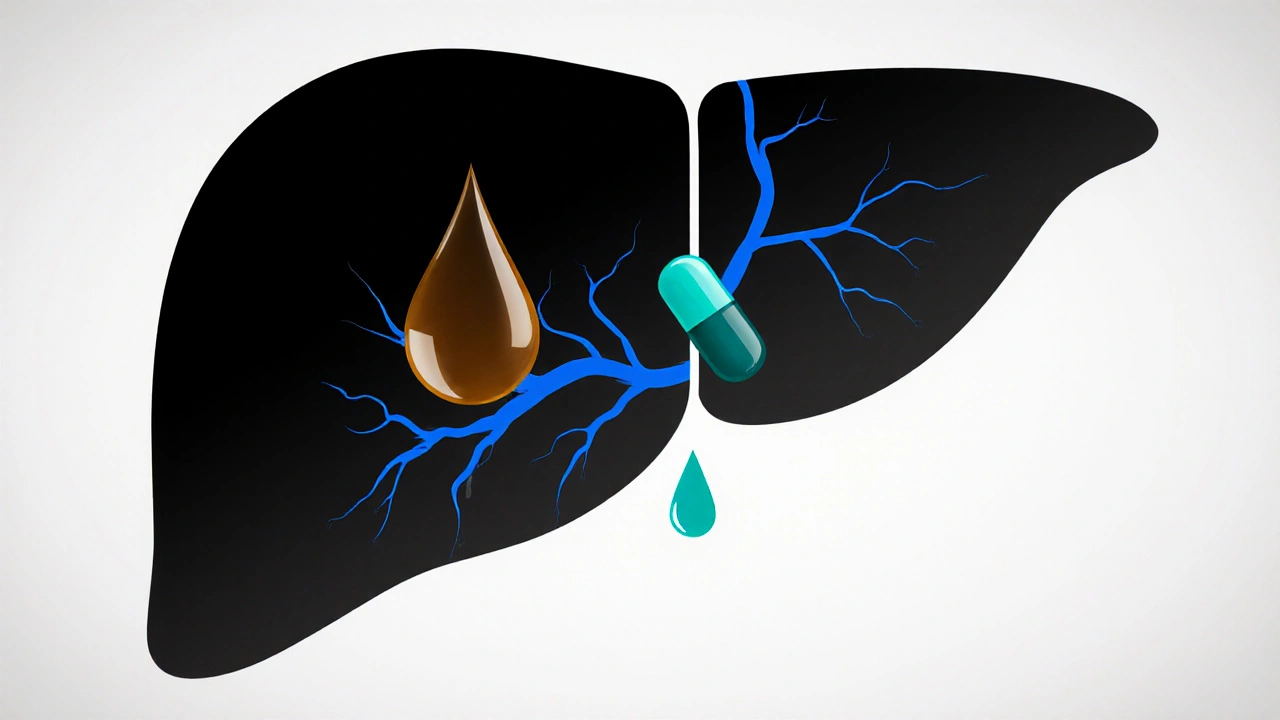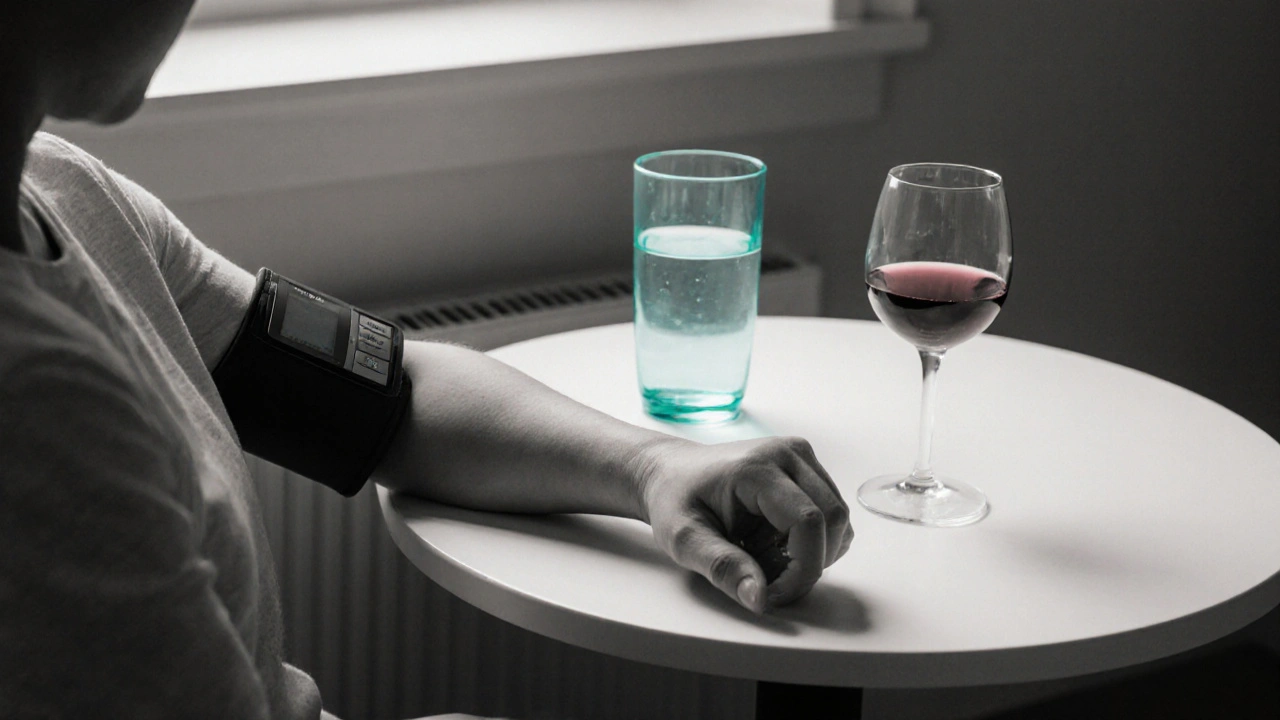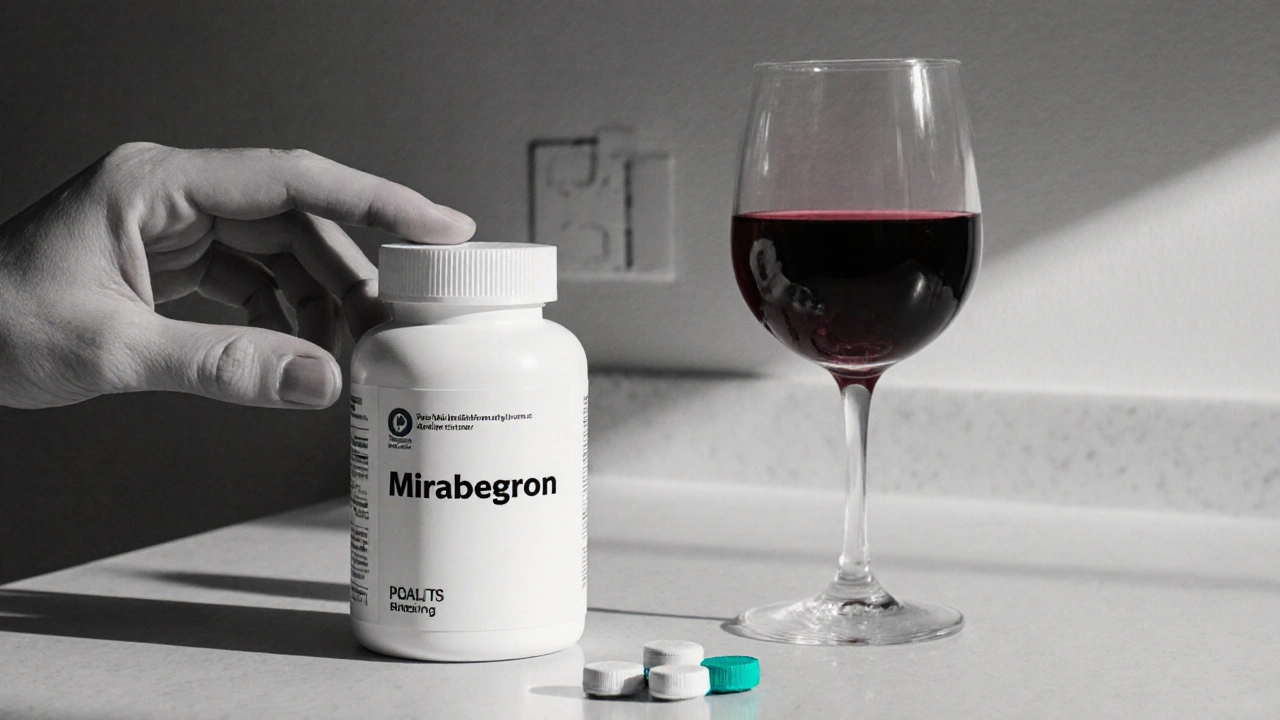Mirabegron Alcohol Risk Calculator
How Many Drinks Are Safe for You?
Use this tool to estimate your safe alcohol limit based on your mirabegron dosage, health conditions, and other medications. This calculator is designed for occasional moderate drinking only.
Quick Summary
- Mirabegron works mainly on the bladder; it doesn’t directly conflict with alcohol, but both can affect blood pressure and dizziness.
- Mixing them isn’t outright forbidden, but timing, amount, and personal health matter.
- Watch for increased dizziness, rapid heartbeat, or flushing; call a doctor if they appear.
- Stay hydrated, limit drinks to one or two standard units, and avoid driving after taking mirabegron.
- Always discuss your drinking habits with the prescriber for personalized advice.
Wondering if you can enjoy a glass of wine while taking mirabegron and alcohol? The short answer is: it depends on how your body reacts, the dose you’re on, and what other health issues you have. Below we break down the science, the real‑world experience, and practical tips so you can make an informed decision.
What Is Mirabegron?
Mirabegron is a beta‑3 adrenergic agonist prescribed for overactive bladder (OAB). It relaxes the bladder’s detrusor muscle, letting it hold more urine and reducing sudden urges. The typical starting dose is 25mg once daily, sometimes increased to 50mg based on symptom control.
How Alcohol Affects the Body
Alcohol is a central nervous system depressant that dilates blood vessels, lowers blood pressure temporarily, and can cause dehydration. Even moderate consumption can produce mild dizziness, impaired coordination, and a slight increase in heart rate as the liver processes the ethanol.

Potential Interaction Mechanisms
There’s no direct chemical clash between mirabegron and ethanol, but three indirect pathways deserve attention:
- Metabolic Overlap: Mirabegron is broken down mainly by the liver enzymes CYP3A4 (a cytochrome P450 enzyme) and CYP2D6 (another liver enzyme). Alcohol also taxes these enzymes, especially with chronic drinking, potentially slowing mirabegron clearance and raising its blood levels.
- Blood Pressure Shifts: Mirabegron can cause a modest rise in systolic pressure (about 3‑5mmHg). Alcohol, on the other hand, initially drops pressure but may rebound higher after the first hour. The combined swing can feel like light‑headedness in sensitive individuals.
- Central Nervous System Effects: Both substances can induce dizziness or a “spaced‑out” feeling. When they happen together, the sensation may be amplified, increasing fall risk.
What the Research Says
Clinical trial data on mirabegron rarely mention alcohol because most studies screen out heavy drinkers. However, a 2022 post‑marketing safety review of 5,300 patients noted that Side Effects like dizziness, headache, and increased heart rate were slightly more common in participants who reported regular alcohol intake. The increase was modest-about 1.3% higher than in abstinent users.
A 2023 pharmacokinetic study measured mirabegron plasma concentrations after a single 50mg dose taken with a standard 150ml glass of red wine. The peak level rose by just 6%, a change considered clinically insignificant for most patients. The authors concluded that occasional moderate drinking is unlikely to cause dangerous levels, but they warned against binge drinking or combining with other blood‑pressure‑affecting drugs.
Practical Guidance for Patients
Here’s a checklist you can use the next time you’re reaching for a drink:
- Know your dose: If you’re on the low 25mg dose and have no heart‑rate issues, the risk is lower.
- Limit quantity: One standard drink (≈14g of alcohol) is a safe ceiling for most adults on mirabegron.
- Mind timing: Take mirabegron with food in the morning, and keep alcohol to the evening. Giving your body a few hours between the two reduces overlap.
- Stay hydrated: Alcohol dehydrates, which can worsen urinary symptoms. Drink a glass of water between each alcoholic beverage.
- Watch your blood pressure: If you have hypertension, check your BP before and after drinking. A rise of more than 10mmHg should trigger a pause.
- Avoid other sedatives: Mixing mirabegron, alcohol, and antihistamines or benzodiazepines can amplify dizziness.

When to Call a Doctor
If any of the following occur, seek medical advice promptly:
- Persistent heart palpitations or a resting rate above 100bpm.
- Sudden, severe headache or visual changes.
- Marked dizziness that doesn’t resolve within 30minutes of stopping drinking.
- Unusual urinary urgency or incontinence that spikes after alcohol.
These symptoms could indicate that alcohol is pushing mirabegron into a higher‑risk zone for you personally.
Common Myths Debunked
Myth 1: “You must never drink while on mirabegron.”
Reality: Occasional moderate consumption is generally tolerated, especially if you monitor how you feel.
Myth 2: “A single drink will cause a dangerous spike in blood pressure.”
Reality: The rise is typically minimal; the real concern is the combined effect of multiple drinks or other meds.
Myth 3: “Mirabegron neutralizes the effects of alcohol.”
Reality: The drug does not counteract alcohol’s depressant action. You can still feel the typical after‑effects of drinking.
Potential Effects of Mixing Mirabegron with Alcohol
| Effect | Likelihood | Severity | Management |
|---|---|---|---|
| Dizziness | Low‑to‑moderate (≈10% of users) | Mild-moderate | Sit down, hydrate, avoid driving |
| Increased heart rate | Rare (≈3% of users) | Moderate | Check pulse, limit drinks, consult GP if persistent |
| Heightened urinary urgency | Uncommon | Low | Track fluid intake, use bladder training techniques |
| Blood‑pressure swing | Very rare | Moderate-severe (if hypertensive) | Monitor BP, reduce alcohol, discuss dose adjustment |
Frequently Asked Questions
Can I have a glass of wine with my mirabegron dose?
Yes, one standard glass (≈150ml) is usually safe if you’re on the usual 25‑50mg dose and have no other heart‑rate or blood‑pressure issues. Stay aware of how you feel and avoid binge drinking.
Does binge drinking make mirabegron ineffective?
Binge drinking can temporarily raise mirabegron levels, leading to stronger side‑effects, but it doesn’t erase the drug’s bladder‑relaxing action. The main risk is increased dizziness or rapid heartbeat.
I’m on other blood‑pressure meds-does that change anything?
Absolutely. Combining mirabegron, alcohol, and antihypertensives can cause additive blood‑pressure swings. Talk to your GP about adjusting doses or spacing out the timing of each.
What if I feel dizzy after a drink?
Sit or lie down, sip water, and avoid driving. If dizziness lingers for more than 30minutes or is accompanied by a fast pulse, call your healthcare provider.
Should I stop drinking completely while on mirabegron?
Not necessarily. Moderate, occasional drinking is acceptable for most patients. Complete abstinence is only advised if you have severe hypertension, a history of falls, or if your doctor specifically recommends it.

17 Responses
Great overview! 🎉 It's awesome that you laid out the risks and gave practical tips. Staying hydrated and keeping track of blood pressure are key when mixing mirabegron and alcohol. I also love the printable table – makes it super easy to reference. Keep up the good work! 😊
I appreciate the clear dosage guidelines. The summary table is especially helpful.
This post hits the sweet spot between science and everyday advice. The explanation of CYP3A4 involvement was spot on, and I’ve never seen it broken down so clearly. I also like the reminder to check blood pressure before and after a drink – that’s a habit I’ll adopt. Thanks for the balanced tone; it feels neither alarmist nor dismissive.
While the article is thorough, I can’t help but notice the lack of discussion about alternative bladder therapies that avoid any interaction risk altogether. Isn’t it a bit presumptuous to suggest moderate drinking when many patients could simply switch to behavioral interventions? Moreover, the “one‑standard‑drink” rule feels arbitrarily conservative given the pharmacokinetic data showing only a 6% increase in plasma levels. Perhaps a more nuanced, patient‑specific approach would be preferable over these blanket statements.
Honestly, the premise that anyone should risk even a slight dizziness while on medication is questionable. We must prioritize safety over convenience. The author should have highlighted the moral responsibility of physicians to counsel complete abstinence for high‑risk individuals. Also, note: “mirabegron” should always be capitalized as a brand name when used in formal writing.
Sure, “moderate” drinking is fine – if you enjoy living on the edge of a fainting spell.
That’s a bit harsh. Most patients can handle a glass of wine without any drama, especially if they follow the suggested timing.
Honestly, telling people they can “handle” alcohol downplays the real risks for those with hypertension. A more cautious tone would be responsible.
Let’s stay motivated! 🎯 Keep an eye on your intake, hydrate between drinks, and you’ll keep both your bladder and your heart happy. Small steps lead to big health wins.
Love the colorful breakdown – it’s like a cheat‑sheet for anyone juggling meds and a social life. 🍷👍 Remember, the key is moderation and listening to your body.
In our country, we don’t compromise on health for a cheap bottle of wine! The synergy between mirabegron and ethanol can trigger a cascade of hemodynamic turbulence, jeopardizing not just the bladder but the entire cardiovascular matrix. If you value your nation’s progress, you’ll ditch the drink and stick to evidence‑based protocols. This isn’t a suggestion – it’s a mandate for responsible citizenship.
While I respect the passionate tone, the claim that “any drink jeopardizes the entire cardiovascular matrix” overstates the evidence. The data show a modest 6% increase in plasma levels, which is clinically insignificant for most. Let’s keep the discussion grounded in the actual risk profile rather than alarmist rhetoric.
Reading through this guide reminded me of how far we’ve come in patient‑centered care, where information is not just a list of dosages but a narrative that empowers individuals to make informed choices. First, the clear explanation of mirabegron’s mechanism of action demystifies a drug that many patients hear only as a “bladder pill.” Second, the inclusion of a risk calculator, even if simplified, signals a move toward personalized medicine rather than one‑size‑fits‑all advice. Third, the emphasis on hydration and timing reflects a practical understanding that life doesn’t pause for medication schedules. Fourth, the cautionary notes about blood‑pressure swings are crucial, especially for those already on antihypertensive regimens; a small lapse can cascade into a serious event. Fifth, the table summarizing potential side‑effects is a visual aid that many users appreciate over dense paragraph text. Sixth, the Q&A section anticipates common concerns, reducing the need for patients to hunt down answers elsewhere. Seventh, the author’s reminder to consult a healthcare professional acknowledges that self‑management has limits. Eighth, the post respectfully debunks myths without sounding condescending, which builds trust. Ninth, the tone overall provides reassurance while still delivering necessary warnings – a delicate balance that not all health blogs achieve. Tenth, the advice to limit alcohol to one or two standard drinks aligns with broader public health guidelines, reinforcing consistency across recommendations. Eleventh, the mention of avoiding other sedatives or antihistamines when drinking underlines the importance of considering drug‑drug interactions beyond the primary medication. Twelfth, the suggestion to monitor one’s own blood pressure after a drink gives a practical, actionable step. Thirteenth, the encouragement to stay hydrated before, during, and after drinking acknowledges the diuretic effect of both alcohol and mirabegron. Fourteenth, the final call to discuss personal drinking habits with a prescriber puts the patient‑doctor relationship at the forefront of safe medication use. All in all, this guide serves as a model for how health information should be presented – clear, compassionate, evidence‑based, and actionable.
Boost your confidence by tracking those drinks! 📊 Use the calculator, stay hydrated, and remember – the goal is a healthy bladder, not a blackout. Let’s keep the conversation lively but safe! 🚀
Risk is real.
Indeed, the statement "Risk is real" encapsulates the core warning; consequently, readers should heed the recommendation to monitor blood pressure, hydrate adequately, and consult their physician before consuming alcohol while on mirabegron.
From a philosophical standpoint, the interplay between pharmacology and personal liberty invites us to consider the ethics of self‑regulation. When a drug subtly alters our physiological baseline, the choice to consume alcohol becomes an act of informed consent that must be anchored in transparency. If the healthcare system provides tools like this calculator, then it also bears responsibility to ensure the data are accessible and interpretable across diverse literacy levels. Moreover, we should contemplate how societal norms around drinking shape our risk perception – are we normalizing a behavior that, for a subset of patients, could precipitate harm? The answer lies not just in individual caution but in collective dialogue, where clinicians, patients, and policymakers collaborate to refine guidelines that respect both autonomy and safety. Ultimately, embracing a holistic view that integrates medical evidence with lived experience can transform this conversation from a checklist of symptoms to a shared journey toward well‑being.